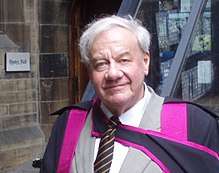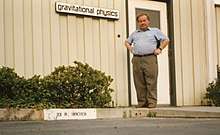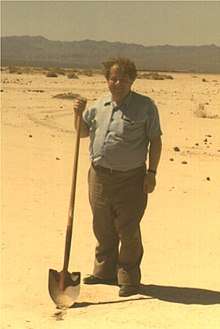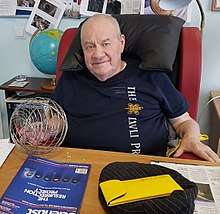Ronald Drever
| Ron Drever | |
|---|---|
 Ronald Drever in Glasgow 2007 | |
| Born |
Ronald William Prest Drever 26 October 1931[1] Bishopton, Renfrewshire, Scotland, UK |
| Died |
7 March 2017 (aged 85)[1] Edinburgh, Scotland, UK |
| Nationality | British |
| Citizenship | British |
| Alma mater | University of Glasgow (PhD) |
| Known for |
Laser stabilizing technique Pioneering laser interferometric gravitational wave observation. |
| Awards |
|
| Scientific career | |
| Fields | Physics, Laser physics, Experimental Gravitation |
| Institutions | California Institute of Technology, University of Glasgow |
| Thesis | Studies of orbital electron capture using proportional counters (1959) |
| Website |
www |
Ronald William Prest Drever (26 October 1931 – 7 March 2017) was a Scottish experimental physicist. He was a professor emeritus at the California Institute of Technology, co-founded the LIGO project, and was a co-inventor of the Pound–Drever–Hall technique for laser stabilisation, as well as the Hughes–Drever experiment. This work was instrumental in the first detection of gravitational waves in September 2015.[2][3][4][5][6][7]
Drever died on 7 March 2017, aged 85,[8] seven months before his colleagues Rainer Weiss, Kip Thorne, and Barry Barish won the Nobel Prize in Physics for their work on the observation of gravitational waves.[9] It is generally believed that he would have won the Nobel Prize in the place of Barry Barish had he not died before the Nobel Committee made their decision.
Education
Drever was educated at Glasgow Academy followed by University of Glasgow where he was awarded a bachelor's degree in 1953[10] followed by a PhD in 1959 for research on orbital electron capture using proportional counters.[11]
Career and research
After receiving his PhD from the University of Glasgow in 1959, Drever initiated the Glasgow project to detect gravitational waves in the sixties,[12] after which he established the University’s first dedicated gravitational wave research group in 1970.[13] The same year Drever was recruited to form a gravitational wave program at Caltech.[14] In 1984 Drever left Glasgow to work full-time at Caltech.[15]
Drever's contributions to the design and implementation of the LIGO interferometers were critically important to their ability to function in the extreme sensitivity realm required for detection of gravitational waves (10−23 strain).
Drever's final work involved the development of magnetically levitated optical tables for seismic isolation of experimental apparatus.[16]



Honors and awards
Drever was recognized by numerous awards including:
- Inducted into the American Academy of Arts and Sciences [17] (2002)
- Shared the Einstein Prize (2007) with Rainer Weiss
- The Special Breakthrough Prize in Fundamental Physics (2016)
- The Gruber Prize in Cosmology (2016)
- The Shaw Prize (2016) (together with Kip Thorne and Rainer Weiss).[18]
- The Kavli Prize in Astrophysics (2016).[19]
- Smithsonian, American Ingenuity Award (2016)
- The Harvey Prize (2016)
- Fellowship of the Norwegian Academy of Science and Letters[20]
See also
References
- 1 2 "Caltech Mourns the Passing of LIGO Co-founder Ronald W. P. Drever". Whitney Clavin. Caltech. 8 March 2017. Retrieved 10 March 2017.
- ↑ Knapton, Sarah (12 February 2016). "British scientist who played key role in gravitational waves research is suffering from dementia". The Telegraph. Telegraph Media Group Limited. Retrieved 12 February 2016.
- ↑ Twilley, Nicola. "Gravitational Waves Exist: The Inside Story of How Scientists Finally Found Them". The New Yorker. ISSN 0028-792X. Retrieved 2016-02-11.
- ↑ Abbott, B.P.; et al. (2016). "Observation of Gravitational Waves from a Binary Black Hole Merger". Phys. Rev. Lett. 116: 061102. arXiv:1602.03837. Bibcode:2016PhRvL.116f1102A. doi:10.1103/PhysRevLett.116.061102. PMID 26918975.
- ↑ Naeye, Robert (11 February 2016). "Gravitational Wave Detection Heralds New Era of Science". Sky and Telescope. Retrieved 11 February 2016.
- ↑ Castelvecchi, Davide; Witze, Alexandra (11 February 2016). "Einstein's gravitational waves found at last". Nature News. doi:10.1038/nature.2016.19361. Retrieved 11 February 2016.
- ↑ Cho, Adrian (2016). "Will Nobel Prize overlook master builder of gravitational wave detectors?". Science. doi:10.1126/science.aah7350. ISSN 0036-8075.
- ↑ "Gravitational waves pioneer Ronald Drever dies". Jonathan Amos. BBC. 8 March 2017. Retrieved 10 March 2017.
- ↑ "Nobel Prize in Physics 2017 press release". nobelprize.org.
- ↑ Anon (2016). "The University of Glasgow Story: Ronald Drever". universitystory.gla.ac.uk. Glasgow: University of Glasgow. Archived from the original on 2016-12-05.
- ↑ Drever, Ronald William Prest (1959). Studies of orbital electron capture using proportional counters (PhD thesis). University of Glasgow. OCLC 298416389.
- ↑ Prof R G Moorhouse (23 August 2002). "Gravitational Waves Detected, Confirming Einstein's Theory". The Herald Scotland. The Herald Scotland. Retrieved 28 December 2017.
- ↑ "£500K BEQUEST MAKES SPLASH WITH GLASGOW GRAVITATIONAL WAVE SCIENTISTS". gla.ac.uk. University of Glasgow. 28 December 2017. Retrieved 28 December 2017.
- ↑ OVERBYE, DENNIS , CORUM, JONATHAN and DRAKEFORD, JASON (11 February 2016). "Gravitational Waves Detected, Confirming Einstein's Theory". New York Times. The New York Times Company. Retrieved 12 February 2016.
- ↑ Prof R G Moorhouse (28 December 2017). "£500K BEQUEST MAKES SPLASH WITH GLASGOW GRAVITATIONAL WAVE SCIENTISTS". gla.ac.uk. University of Glasgow. Retrieved 28 December 2017.
- ↑ S. J. Augst & R. W. P. Drever (2000). "Measurements of Mechanical Q in Levitated Paramagnetic Crystals" (PDF). Amaldi Conference 2000. Caltech.
- ↑ Five Caltech Faculty Members Elected to Membership in the American Academy of Arts and Sciences Archived 2010-06-01 at the Wayback Machine.
- ↑ Shaw Prize 2016
- ↑ "2016 Kavli Prize in Astrophysics | www.kavliprize.org". www.kavliprize.org. Retrieved 2016-06-02.
- ↑ "Group 2: Astronomy, Physics and Geophysics". Norwegian Academy of Science and Letters. Archived from the original on 22 December 2017. Retrieved 22 December 2017.